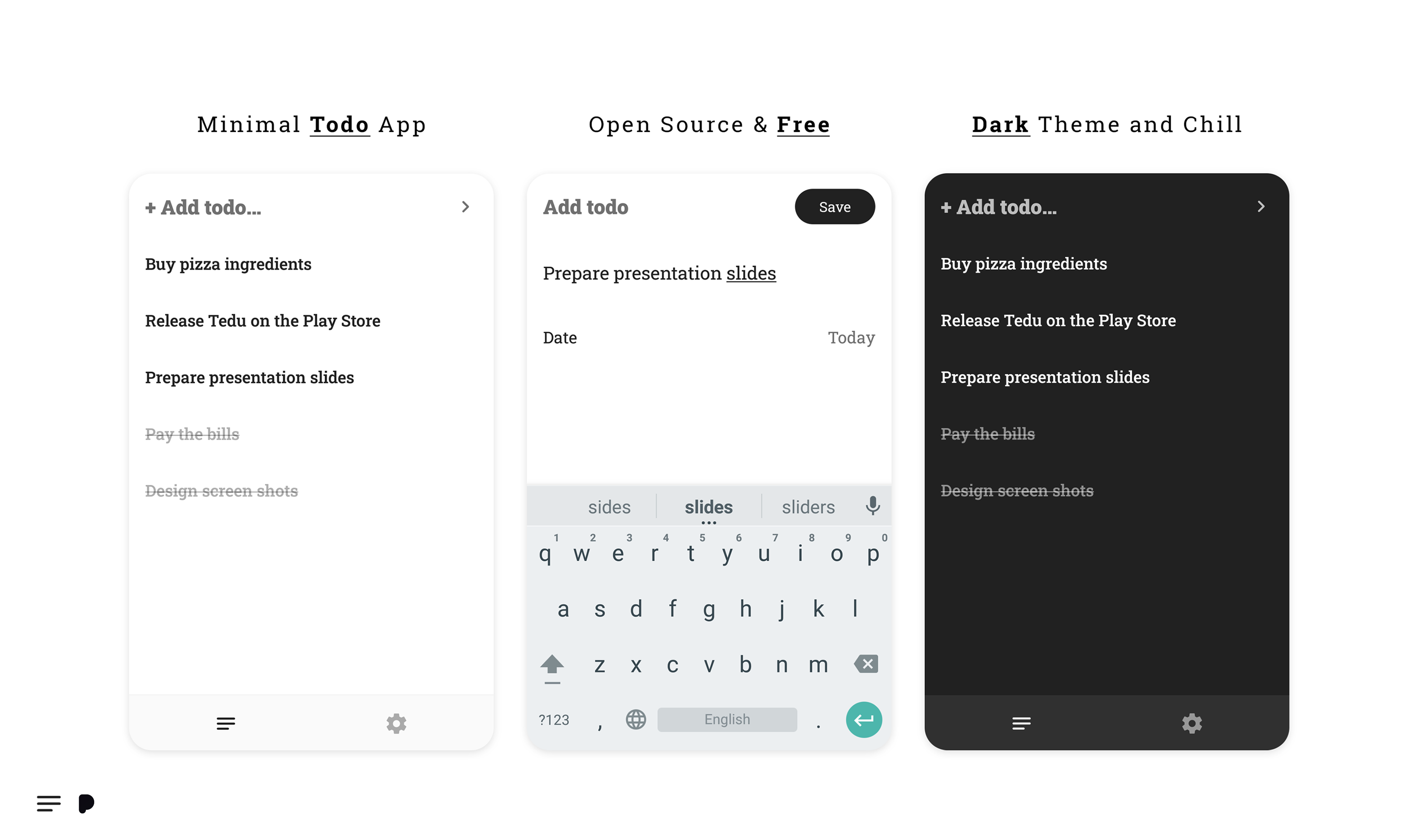Tedu is currently released on Google Play, and you can download it by clicking on the button below:

I believe that everyone can contribute to this project, even without the knowledge in computer science and programming. So please, if you have free time, consider contributing to this project in these areas:
- Report a bug. If you've ever encountered a bug in the app, please consider reporting it through this link. If you think this is too complicated, it's totally fine, and you can report the bug in plain English to me through this phelatco@gmail.com email address.
- Propose a feature. If you think a feature is missing from the app, please consider proposing it through this link. If you think this is too complicated, it's totally fine, and you can propose the feature in plain English to me through this phelatco@gmail.com email address.
- Translate. If you are familiar with a language other than English, you can help to translate the app to that language, and it's pretty straight forward, you don't need to be a computer expert or anything, I'm just going to send you a list of words and sentences that we've used in the app, and you'll send us their translation. It's that simple, and to get started, send me an email(phelatco@gmail.com) so that I could send you the list of words and sentences.
- Pull request. If you are a software engineer and understand Kotlin, you can help and contribute to this project by working on the reported bugs, refactor the code and keep it fresh, or even implement a new feature that you think it's cool to have(But before that, make sure to contact me and describe what you want to achieve).
As you know, this project is free and doesn't have annoying ads; hence, it's not profitable. But you can always keep a developer motivated by buying them a cup of coffee. This surely helps me to develop and maintain the app.


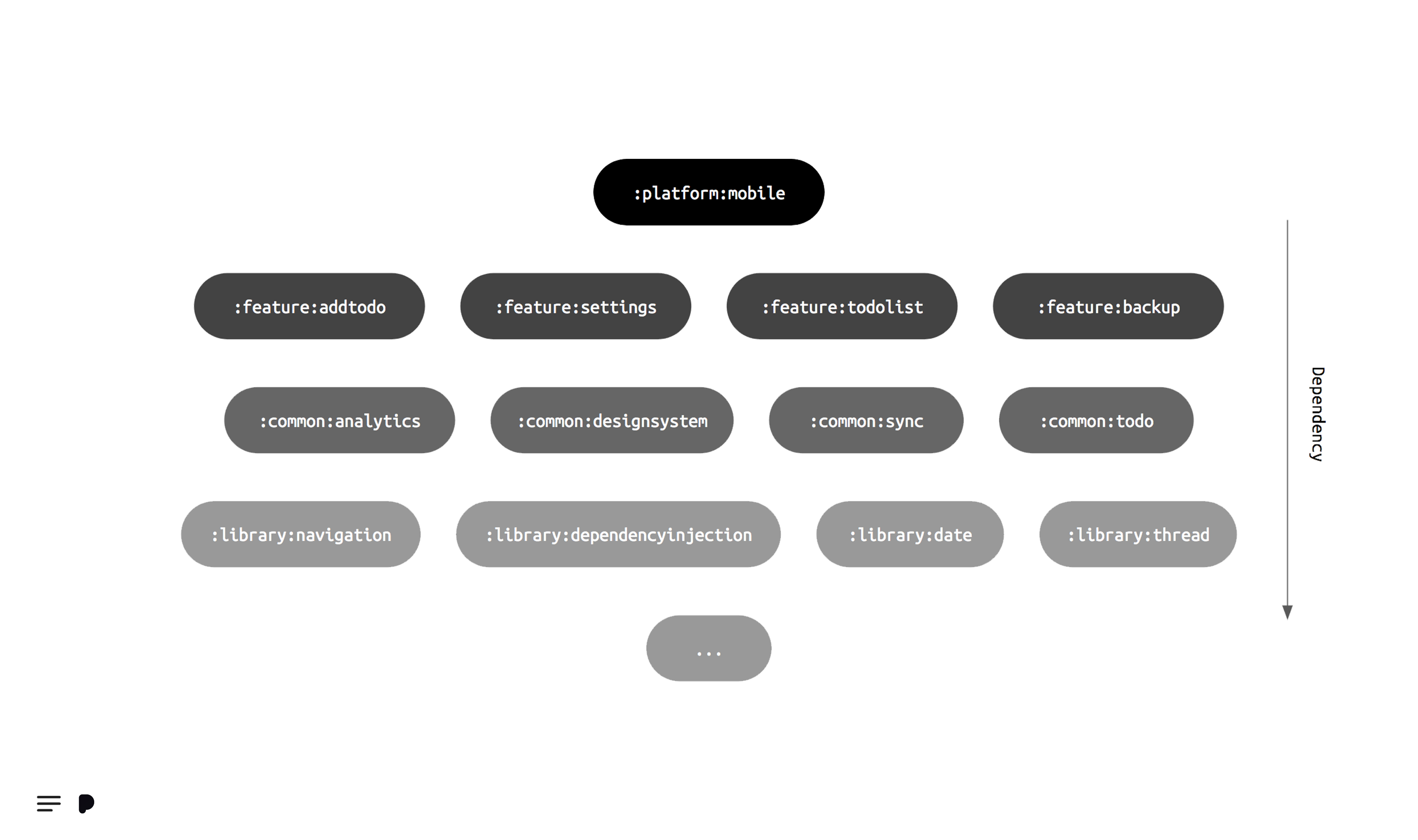
At my current job at Cafe Bazaar, we were trying to migrate our Android project to a modular structure so we could scale our Android chapter in the long-term. This project's architecture is the result of my research and development on the idea of having a modular Android project, and I tried to solve all the challenges that one could face when migrating to a modular structure.
📱📲 Navigation
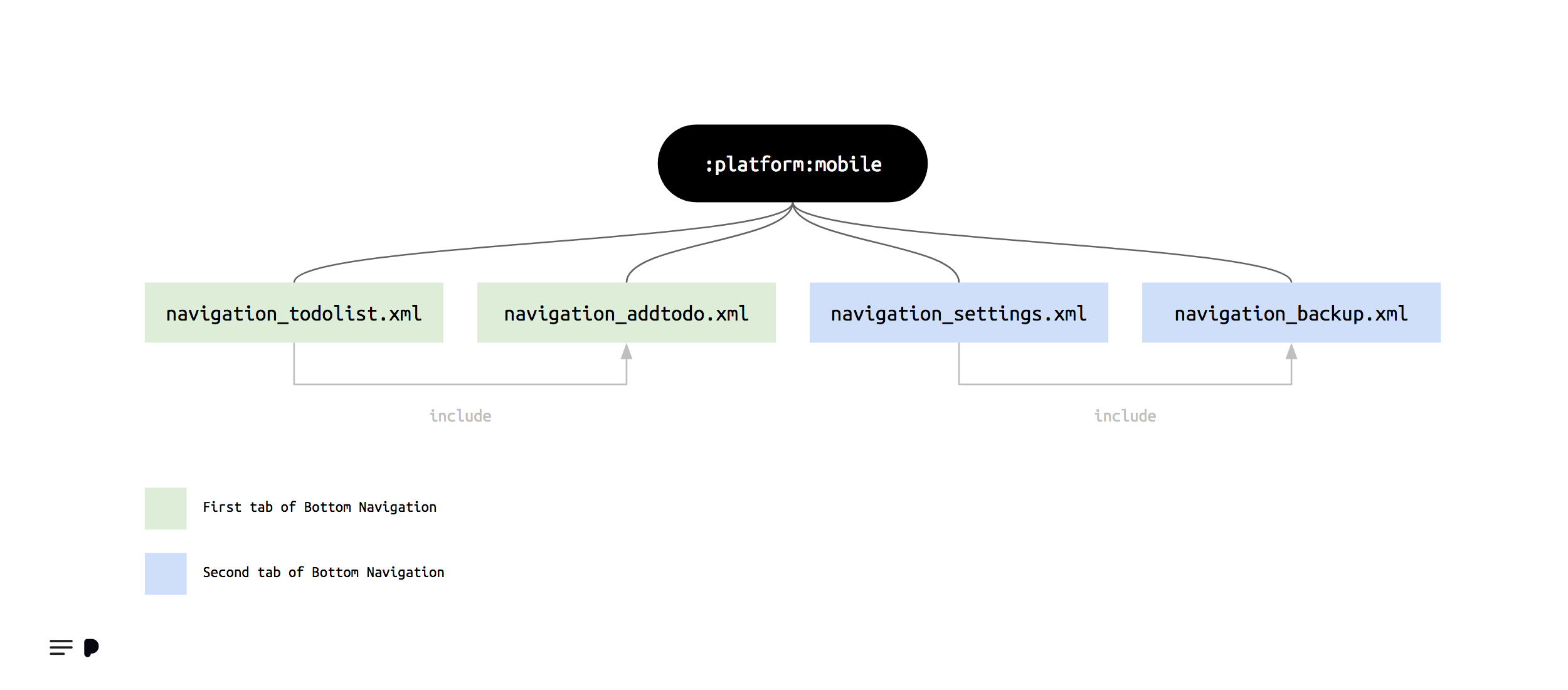
Handling navigation in a modular structure could be challenging, especially if you are using the Jetpack's Navigation Component. What I've come up with is a structure in which every feature module has its navigation graph, and their graph file resides in the platform module, in this case, the :platform:mobile module. Navigation inside a module is done using the Actions, and nothing differs here from a monolith project, but to navigate between modules(inter-module navigation), I've used deep-links with the help of Navigation Component's deep-linking feature. Now, this has two issues, first is that the SafeArgs plugin can't help us to have type safety when we are using deep-links and the second is that, we can't pass Parcelable/Serializable data between destinations. For the first issue, I haven't done anything because I didn't have the time to implement a Gradle plugin like SafeArgs for deep links, but for the second issue, I've implemented an extension function for the NavController called interModuleNavigate which receives two parameters:
- The deep link URI that we want to navigate to.
- The marshalable data(Parcelable/Serializable) that you want to pass to the destination.
And it's used like this:
findNavController().interModuleNavigate(
getString(R.string.deeplink_userprofile).toUri(),
userEntity
)We store deep-link values in a string resource file so that we could use them in the navigation graph file for defining a deep-link destination and also use them at the runtime to navigate to that destination. Now that you've understood how the front-end of this implementation is used, let's talk about its back-end and how things look behind the curtain. Since we normally can't pass Parcelable/Serializable data using deep-links, I've decided to write the data on the disk and then read it afterward. Every deep-link that is used for inter-module navigation and requires to pass a marshallable data, needs to have a query called extraData. We set this query's value at the runtime, and it's a timestamp, fetched from System.currentTimeMillis. We use this timestamp to name the file that we are going to write on the disk, so in the destination, we would know what file to read from to access the marshalled data. Since we are passing the timestamp as part of the deep-link's URI, we don't have to worry about losing it in configuration changes or process death, because every query is saved inside Fragment's argument bundle and we know that Fragment will take care of its argument bundle automatically and stores it when onSaveInstanceState happens. All of this is happening inside the :library:navigation module if you want to take a look.
💉 Dependency Injection
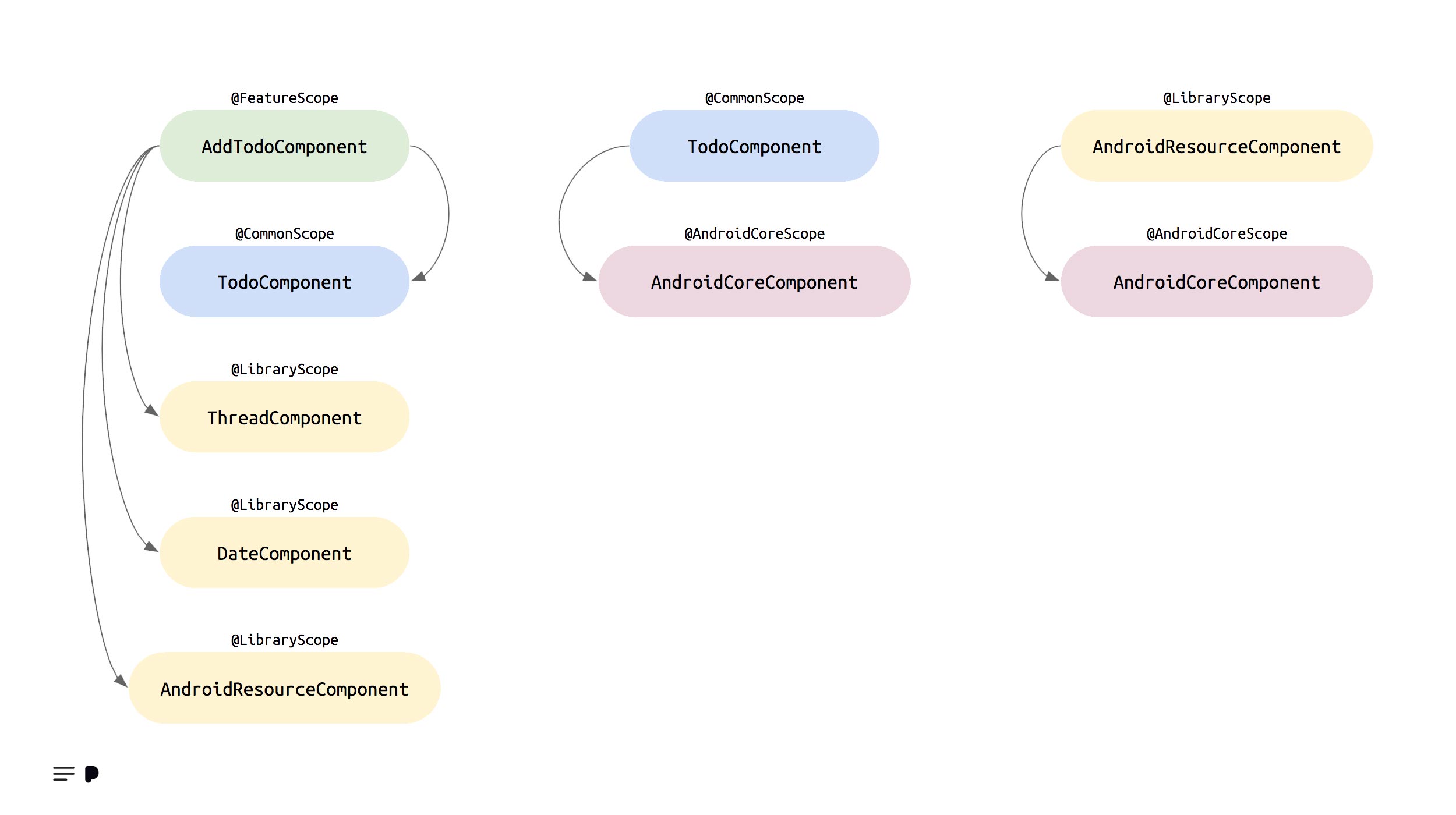
I've used dagger-android for dependency injection purposes. One important thing to note here is that dagger-android isn't usable in a modular structure as-is, and I've extended it to be able to use it in a modular structure. You can find the extension source code in :library:androiddagger and :library:dependencyinjection modules.
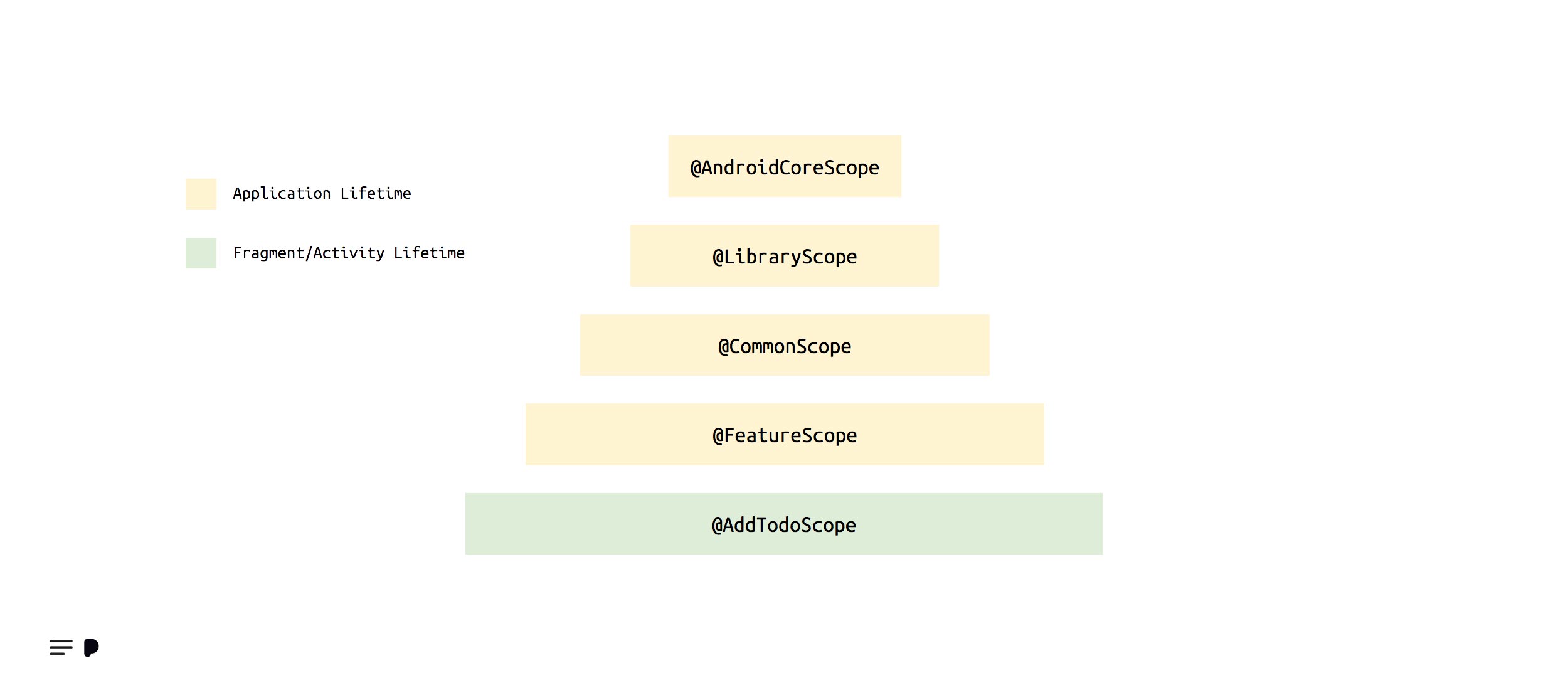
In the above image, you can see the scope hierarchy that I've used. Yellow ones are Singleton, and the green one is bounded to a Fragment lifecycle, in this case, the AddTodoFragment. One weird scope in the above image is @AndroidCoreScope, which is the root scope and dependency-wise, it only contains the Application and Application's Context dependencies; therefore, it's one level higher than @LibraryScopes, so that library components could access the Application class and its Context. These scopes(except @AddTodoScope), are implemented in the :library:dependencyinjection module and whoever needs to use them requires to depend on this Gradle module. In dagger-android world, there is an annotation called @ContributesAndroidInjector which is used by dagger-android's annotation processor to generate sub-components and then they all will be collected in a class called DispatchingAndroidInjector; Now, we have a limitation here, since dagger-android technically supports just one DispatchingAndroidInjector and since we have several feature modules, each of them will have their own DispatchingAndroidInjector, so we need to merge them somehow. To solve this issue, I've implemented a base class for the Application class, called DaggerAndroidApplication which has a function called installFeature, and receives a feature component and stores that component in a HashMap, so then we could use the HashMap to fetch a DispatchingAndroidInjector that we need and inject it to our Fragment/Activity. If you take a look in the Tedu class, which is the Application class, you'll see these lines, that is used to install a feature:
override fun onCreate() {
super.onCreate()
installFeature(TodoListComponentBuilder)
installFeature(AddTodoComponentBuilder)
installFeature(SettingsComponentBuilder)
installFeature(BackupComponentBuilder)
}In the code above, you can see that we are passing Builder objects, which is a new concept in my dagger-android implementation. If we want to achieve a better build speed because of our modular structure, we need to let each module build its component on its own and to do this, we need to have Singleton instance of that component so that all the dependant components could use a single instance. Component Builder is the place where we build the component and in its underlying layer, it will save the built component in a singleton manner. Now to inject a component in our Fragment/Activity, there is an extension function called inject which accepts a generic that is used to determine what DispatchingAndroidInjector you want to use:
override fun onAttach(context: Context) {
super.onAttach(context)
inject<AddTodoComponent>()
}